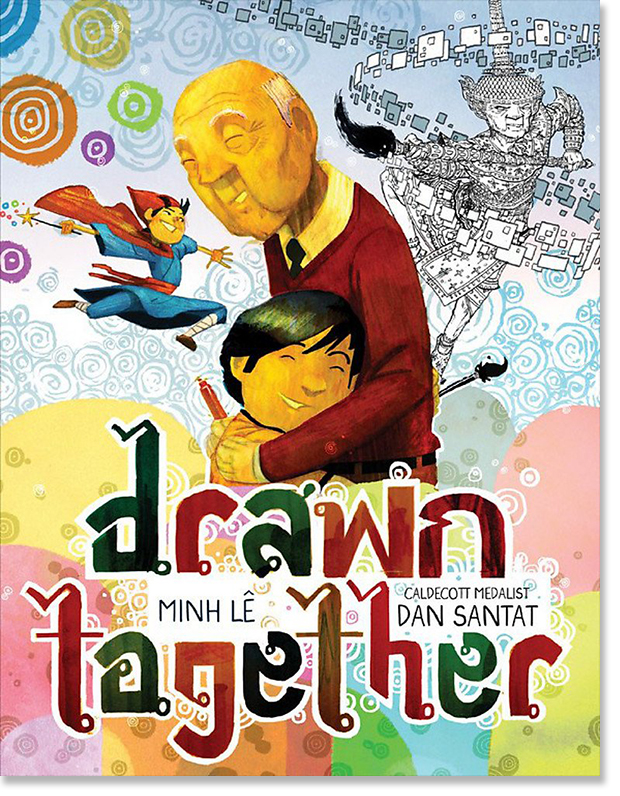
Earlier this year, I came across a book that struck a personal chord and made me wonder about its genesis. What made it stand out above others?
Then I had a chance to hear the author, Minh Le, talk about it. I knew he had a background in early childhood policy and has two young children of his own.
His first book, Let Me Finish (Disney/Hyperion), illustrated by Isabel Roxas, shows a sensitivity to young children as young as 3 years old and up to 5 or 6 years old. It also demonstrates an awareness of what it’s like to want to enjoy a good story but have a tough time finding the quiet to read. (One certainly doesn’t need to be a preschooler to appreciate that!)
His newest book, Drawn Together (Disney Hyperion), illustrated by Dan Santat, is really for older readers (and by older I mean not only children in K-4 but high school students and even adults). It’s about the power of story in words and image to connect people.
He’ll be at the National Book Festival which will be held in Washington, DC, on Saturday, September 1, 2018. Dan Santat and a host of other authors and illustrators will be there, too. It’s a great chance to hear about new books, to buy them if you want, and to get them signed by the creators. Even if you can’t make the Festival, the Library of Congress will post the presentations online.
Minh has agreed to answer a few questions for this interview, so here goes:
Tell us about the origin of Drawn Together

The editor for my debut picture book (Let Me Finish) was the wonderful Rotem Moscovich. She had also worked with Dan in the past so when he won the Caldecott, she took him out to celebrate. That’s where she mentioned that she thought we would make a good pair.
Dan was thankfully open to the idea, so that night I got a life-altering email from my agent that night (the fantastic Stephen Barbara at InkWell Management) saying that we had the chance to work with Dan and I needed to come up with 2-3 story ideas within a few days. We had to strike right away before Dan was swept up in the Caldecott whirlwind.
No pressure or anything!
My wife and I had just come home from the hospital after the birth of my second son, so I have a very vivid memory of being up at 3 am, rocking my newborn to sleep and trying to come up with a story worthy of an illustrator who just won THE BIGGEST AWARD IN CHILDREN’S LITERATURE. Drawn Together is the story that came out of that time.
It is perfectly complemented by Dan Santat’s art. How did you and he collaborate? And frankly, isn’t unusual for an author to be in touch with the illustrator?
Actually, while Dan and I had met before, he and I didn’t communicate at all during the process. It wasn’t until we interviewed each other for Publisher’s Weekly that we finally talked about the book together.
But I have always been a huge fan of Dan’s art, so when I was trying to come up with a story idea to pitch him, part of my process was asking myself: What do I want to see Dan illustrate?
He’s got such a dynamic quality to his art, but also with a book like [The Adventures of] Beekle (which is an absolute favorite of mine), there’s so much heart there as well. So I wanted to come up with a story that touched upon bother of those things: something that resonates on a personal level, but also had an element of excitement and action as well. Once I came up with a story concept that could fold in all that, it was a delight to hand it off to Dan to see what he could come up with.
What was the influence of your different backgrounds on this book?
The story is very much based on my relationship with my grandparents, in particular with my paternal grandfather. Vietnamese was actually my first language, but I slowly let it slip over time. So since my grandparents spoke primarily Vietnamese and I spoke mostly English, our relationship was very much defined by what we could not say to each other.
So Drawn Together is both about the awkward silences that come with the language, generational, and cultural divides, but also how these important relationships can and do thrive despite those challenges. And perhaps most importantly, that it’s worthwhile to find those bridges that can connect us to the people we love, despite the things that divide us.
I didn’t know it at the time, but it turns out that Dan had a similar dynamic with his Thai-speaking grandmother. I think it’s evident in his artwork that he brought so much personal experience and emotion to the book and that really brings the story to life.
One of the things I most appreciated about this book is the space between the words and the images. Plus there’s space for the reader (of any age) to interpret the story. How was this achieved? In other words, how cognizant are you of the way a picture books works best? Was it intentional?
I absolutely love the picture book format for so many reasons, but particularly the interplay between text and illustration. Even though I am a writer, my favorite books are those that are carried by the illustrations. So I write my manuscripts so that they leave a lot of room for the illustrator to work their magic. And when you’ve had the opportunity to work with the talented people that I have, it’d be foolish not to make full use of their talents as artists and storytellers.
And of course, you need an awesome editor and art director (Hi Rotem and Joann!) to manage the whole process and make sure it all comes together in the end. I obviously couldn’t be more thrilled with how the book turned out. The way I describe it to people is: Dan took the story to an extraordinary place that I couldn’t have possibly imagined … but at the same time it’s exactly the book I had in mind. Which is the dream
Minh — Is there anything else about Drawn Together that I haven’t explicitly asked but that you’d like to address?
A lot of people have kindly asked: “So, what does your grandfather think about the book?”
Sadly, he passed away the year before the book was published. And while he knew I was working on the book, I never actually told him what this book was going to be about. I just couldn’t figure out the right way to tell him–so my hope was that I would be able to hand the book to him and show him the final product.
While I was never able to do that, it means the world to me that there is a picture of him on the dedication page and that he has a spot on the shelf. And if this book can convince even one person to reach out and connect with someone they love before it’s too late, then my heart will be completely full.
Why and how did you come into the field of children’s book publishing as an author?
I don’t consider myself a particularly ambitious person, but the one (professional) thing in life that I’ve always wanted to do was publish a picture book. For many years I put off that dream, alternating between dismissing it as silly and also wondering, “Who am I?” to be publishing a children’s book.
So I put all that to the side while pursuing a career in education policy — but my heart was always with children’s literature. I blogged and reviewed children’s books on the side, but never took my writing very seriously.
Luckily, my very supportive wife gave me the kick in the pants I needed to finally finish a manuscript and send it out into the world.
What are you working on now?
I have a number of unannounced picture book projects in the works, but I’m also working on a Green Lantern graphic novel for DC Comics’ new middle grade graphic novel imprint: DC Zoom. Whereas Drawn Together is about my relationship with my grandfather, this one is inspired in large part by my relationship with my grandmothers, who are both superheroes in their own right.
Many thanks to Minh Le for taking the time to answer these questions. I, for one, will keep an eye out for his forthcoming books!

